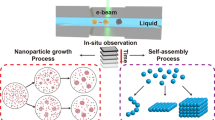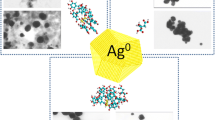Abstract
Linear poly[2-(diethylamino)ethyl methacrylate], poly(DEAMA), is an uncommon example of a homopolymer that can reduce salts of Au and Ag in solution to yield stable dispersions of nanoparticles (5–25 nm typical size). Poly(DEAMA)-stabilized Au and Ag nanoparticles were prepared in a mixture of water and 2-butoxyethanol, an amphiphilic organic solvent. The “loading ratio” (mole ratio of metal atoms to amines), a key parameter influencing particle size and clustering, was systematically varied. The size distribution and clustering of the nanoparticles were characterized by transmission electron microscopy and small-angle X–ray scattering. The maximum loading ratio achievable without inducing precipitation was approximately 0.3 for Au, but the maximum loading ratio for Ag was only about 0.04. The preparation of both Au and Ag nanoparticles in solution with a linear polymeric template illustrates that dendritic or hyperbranched architecture of the polymer is not a prerequisite for obtaining stable, non-aggregated dispersions. From a practical standpoint, poly(DEAMA) is an inexpensive template material that is readily immobilized on silica, which could facilitate development of novel, nanoparticle-based heterogeneous catalysts.
Table of content graphic and summary
TEM image and corresponding particle size distribution of poly(DEAMA)-stabilized gold nanoparticles.










Similar content being viewed by others
References
Aizawa M, Buriak JM (2007) Block copolymer templated chemistry for the formation of metallic nanoparticle arrays on semiconductor surfaces. Chem Mater 19(21):5090–5101
Aslam M, Fu L, Su M, Vijayamohanan K, Dravid VP (2004) Novel one-step synthesis of amine-stabilized aqueous colloidal gold nanoparticles. J Mater Chem 14(12):1795–1797
Bhargava SK, Booth JM, Agrawal S, Coloe P, Kar G (2005) Gold nanoparticle formation during bromoaurate reduction by amino acids. Langmuir 21(13):5949–5956
Burda C, Chen XB, Narayanan R, El-Sayed MA (2005) Chemistry and properties of nanocrystals of different shapes. Chem Rev 105(4):1025–1102
Carotenuto G, Nicolais L (2004) Synthesis and characterization of gold-based mesoscopic additives for polymers. Polym Int 53(12):2009–2014
Castner DG, Hinds K, Grainger DW (1996) X-ray photoelectron spectroscopy sulfur 2p study of organic thiol and disulfide binding interactions with gold surfaces. Langmuir 12(21):5083–5086
Cooper E, Leggett GJ (1998) Static secondary ion mass spectrometry studies of self-assembled monolayers: Influence of adsorbate chain length and terminal functional group on rates of photooxidation of alkanethiols on gold. Langmuir 14(17):4795–4801
Corma A, Garcia H (2008) Supported gold nanoparticles as catalysts for organic reactions. Chem Soc Rev 37(9):2096–2126
Crooks RM, Lemon BI, Sun L, Yeung LK, Zhao MQ (2001a) Dendrimer-encapsulated metals and semiconductors: synthesis, characterization, and applications. Dendrimers Iii Design Dimens Funct 212:81–135
Crooks RM, Zhao MQ, Sun L, Chechik V, Yeung LK (2001b) Dendrimer-encapsulated metal nanoparticles: synthesis, characterization, and applications to catalysis. Acc Chem Res 34(3):181–190
Feng C, Gu L, Yang D, Hu JH, Lu GL, Huang XY (2009a) Size-controllable gold nanoparticles stabilized by PDEAEMA-based double hydrophilic graft copolymer. Polymer 50(16):3990–3996
Feng C, Shen Z, Li YG, Gu LN, Zhang YQ, Lu GL, Huang XY (2009b) PNIPAM-b-(PEA-g-PDMAEA) double-hydrophilic graft copolymer: synthesis and its application for preparation of gold nanoparticles in aqueous media. J Polym Sci Pol Chem 47(7):1811–1824
Figlarz M, Fievet F, Lagier JP (1985) French Patent 8221483. Ref Type: Patent
Grohn F, Bauer BJ, Akpalu YA, Jackson CL, Amis EJ (2000) Dendrimer templates for the formation of gold nanoclusters. Macromolecules 33(16):6042–6050
Haruta M, Date M (2001) Advances in the catalysis of Au nanoparticles. Appl Catal A-Gen 222(1–2):427–437
Hashmi ASK, Hutchings GJ (2006) Gold catalysis. Angew Chem Int Ed 45(47):7896–7936
Hasmy A, Foret M, Pelous J, Jullien R (1993) Small-angle neutron-scattering investigation of short-range correlations in fractal aerogels: simulations and experiments. Phys Rev B 48(13):9345–9353
He JA, Valluzzi R, Yang K, Dolukhanyan T, Sung CM, Kumar J, Tripathy SK, Samuelson L, Balogh L, Tomalia DA (1999) Electrostatic multilayer deposition of a gold-dendrimer nanocomposite. Chem Mater 11(11):3268–3274
Hedden RC, Bauer BJ, Smith AP, Grohn F, Amis E (2002) Templating of inorganic nanoparticles by PAMAM/PEG dendrimer-star polymers. Polymer 43(20):5473–5481
Hoppe CE, Lazzari M, Pardinas-Blanco I, Lopez-Quintela MA (2006) One-step synthesis of gold and silver hydrosols using poly(N-vinyl-2-pyrrolidone) as a reducing agent. Langmuir 22(16):7027–7034
Hostetler MJ, Wingate JE, Zhong CJ, Harris JE, Vachet RW, Clark MR, Londono JD, Green SJ, Stokes JJ, Wignall GD, Glish GL, Porter MD, Evans ND, Murray RW (1998) Alkanethiolate gold cluster molecules with core diameters from 1.5 to 5.2 nm: core and monolayer properties as a function of core size. Langmuir 14(1):17–30
Hutchings GJ, Brust M, Schmidbaur H (2008) Gold—an introductory perspective. Chem Soc Rev 37(9):1759–1765
Ishii T, Otsuka H, Kataoka K, Nagasaki Y (2004) Preparation of functionally PEGylated gold nanoparticles with narrow distribution through autoreduction of auric cation by alpha-biotinyl-PEG-block-[poly(2-(N,N-dimethylamino)ethyl methacrylate)]. Langmuir 20(3):561–564
Iwamoto M, Kuroda K, Zaporojtchenko V, Hayashi S, Faupel F (2003) Production of gold nanoparticles-polymer composite by quite simple method. Eur Phys J D 24(1–3):365–367
Jewrajka SK, Chatterjee U (2006) Block copolymer mediated synthesis of amphiphilic gold nanoparticles in water and an aqueous tetrahydrofuran medium: an approach for the preparation of polymer-gold nanocomposites. J Polym Sci Pol Chem 44(6):1841–1854
Karthikeyan B, Anija M, Philip R (2006) In situ synthesis and nonlinear optical properties of Au:Ag nanocomposite polymer films. Appl Phys Lett 88(5): 053104
Kline SR (2006) Reduction and analysis of SANS and USANS data using IGOR Pro. J Appl Crystallogr 39:895–900
Knecht MR, Pacardo DB (2010) Employing high-resolution materials characterization to understand the effects of Pd nanoparticle structure on their activity as catalysts for olefin hydrogenation. Anal Bioanal Chem 397(3):1137–1155
Kuila BK, Garai A, Nandi AK (2007) Synthesis, optical, and electrical characterization of organically soluble silver nanoparticles and their poly(3-hexylthiophene) nanocomposites: enhanced luminescence property in the nanocomposite thin films. Chem Mater 19(22):5443–5452
Kumar SS, Joseph J, Phani KL (2007) Novel method for deposition of gold-prussian blue nanocomposite films induced by electrochemically formed gold nanoparticles: characterization and application to electrocatalysis. Chem Mater 19:4722–4730
Leff DV, Ohara PC, Heath JR, Gelbart WM (1995) Thermodynamic control of gold nanocrystal size—experiment and theory. J Phys Chem-US 99(18):7036–7041
Lentz DM, Rhoades AM, Pyles RA, Haider KW, Angelone MS, Hedden RC (2011) Combinatorial study of a gold nanoparticle infusion process in a polymer film. J Nanopart Res 13(10):4795–4808. doi:10.1007/s11051-011-0455-3
Liz-Marzan LM (2006) Tailoring surface plasmons through the morphology and assembly of metal nanoparticles. Langmuir 22:32–41
Marty JD, Martinez-Aripe E, Mingotaud AF, Mingotaud C (2008) Hyperbranched polyamidoamine as stabilizer for catalytically active nanoparticles in water. J Colloid Interf Sci 326(1):51–54
Miyamoto D, Oishi M, Kojima K, Yoshimoto K, Nagasaki Y (2008) Completely dispersible PEGylated gold nanoparticles under physiological conditions: modification of gold nanoparticles with precisely controlled PEG-b-polyamine. Langmuir 24(9):5010–5017
Newman JDS, Blanchard GJ (2006) Formation of gold nanoparticles using amine reducing agents. Langmuir 22(13):5882–5887
Newman JDS, Blanchard GJ (2007) Formation and encapsulation of gold nanoparticles using a polymeric amine reducing agent. J Nanopart Res 9(5):861–868
Niu YH, Crooks RM (2003) Dendrimer-encapsulated metal nanoparticles and their applications to catalysis. CR Chim 6(8–10):1049–1059
Ofir Y, Samanta B, Rotello VM (2008) Polymer and biopolymer mediated self-assembly of gold nanoparticles. Chem Soc Rev 37(9):1814–1823
Ramesh GV, Porel S, Radhakrishnan TP (2009) Polymer thin films embedded with in situ grown metal nanoparticles. Chem Soc Rev 38(9):2646–2656
Rieker T, Hanprasopwattana A, Datye A, Hubbard P (1999) Particle size distribution inferred from small-angle X-ray scattering and transmission electron microscopy. Langmuir 15(2):638–641
Roucoux A, Schulz J, Patin H (2002) Reduced transition metal colloids: a novel family of reusable catalysts? Chem Rev 102(10):3757–3778
Sakai T, Alexandridis P (2004) Single-step synthesis and stabilization of metal nanoparticles in aqueous pluronic block copolymer solutions at ambient temperature. Langmuir 20(20):8426–8430
Sangermano M, Yagci Y, Rizza G (2007) In situ synthesis of silver-epoxy nanocomposites by photoinduced electron transfer and cationic polymerization processes. Macromolecules 40(25):8827–8829
Sau TK, Pal A, Pal T (2001) Size regime dependent catalysis by gold nanoparticles for the reduction of eosin. J Phys Chem B 105(38):9266–9272
Schmidt PW, Kalliat M (1984) A simple approximation for calculating the small-angle X-ray and neutron-scattering from polydisperse samples of independently scattering uniform spheres. J Appl Crystallogr 17:27–32
Scott RWJ, Wilson OM, Crooks RM (2005) Synthesis, characterization, and applications of dendrimer-encapsulated nanoparticles. J Phys Chem B 109(2):692–704
Selvakannan PR, Swami A, Srisathiyanarayanan D, Shirude PS, Pasricha R, Mandale AB, Sastry M (2004) Synthesis of aqueous Au core–Ag shell nanoparticles using tyrosine as a pH-dependent reducing agent and assembling phase-transferred silver nanoparticles at the air-water interface. Langmuir 20(18):7825–7836
Selvan ST, Hayakawa T, Nogami M, Moller M (1999) Block copolymer mediated synthesis of gold quantum dots and novel gold-polypyrrole nanocomposites. J Phys Chem B 103(35):7441–7448
Shan J, Tenhu H (2007) Recent advances in polymer protected gold nanoparticles: synthesis, properties and applications. Chem Commun (44): 4580–4598
Sih BC, Wolf MO (2005) Metal nanoparticle—conjugated polymer nanocomposites. Chem Commun (27): 3375–3384
Silvert PY, Herrera-Urbina R, Tekaia-Elhsissen K (1997) Preparation of colloidal silver dispersions by the polyol process. 2. Mechanism of particle formation. J Mater Chem 7(2):293–299
Sohn BH, Seo BH (2001) Fabrication of the multilayered nanostructure of alternating polymers and gold nanoparticles with thin films of self-assembling diblock copolymers. Chem Mater 13(5):1752–1757
Subramaniam C, Tom RT, Pradeep T (2005) On the formation of protected gold nanoparticles from AuCl4–by the reduction using aromatic amines. J Nanopart Res 7(2):209–217
Sun LM, Gardella JA (2002) Oxidation-assisted secondary ion mass spectrometry methodology to quantify mixed alkylthiol self-assembled monolayers on gold: applications to competitive chemical adsorption. Langmuir 18(24):9289–9295
Sun XP, Jiang X, Dong SJ, Wang EK (2003) One-step synthesis and size control of dendrimer-protected gold nanoparticles: a heat-treatment-based strategy. Macromol Rapid Commun 24(17):1024–1028
Uchida M, Klem MT, Allen M, Suci P, Flenniken M, Gillitzer E, Varpness Z, Liepold LO, Young M, Douglas T (2007) Biological containers: protein cages as multifunctional nanoplatforms. Adv Mater 19(8):1025–1042
Ueno T, Suzuki M, Goto T, Matsumoto T, Nagayama K, Watanabe Y (2004) Size-selective olefin hydrogenation by a Pd nanocluster provided in an apo-ferritin cage. Angew Chem Int Ed 43(19):2527–2530
Vasylyev MV, Maayan G, Hovav Y, Haimov A, Neumann R (2006) Palladium nanoparticles stabilized by alkylated polyethyleneimine as aqueous biphasic catalysts for the chemoselective stereocontrolled hydrogenation of alkenes. Org Lett 8:5445–5448
Wiley B, Sun YG, Mayers B, Xia YN (2005) Shape-controlled synthesis of metal nanostructures: the case of silver. Chem Eur J 11(2):454–463
Wilson R (2008) The use of gold nanoparticles in diagnostics and detection. Chem Soc Rev 37(9):2028–2045
Wu T, Zhang YF, Wang XF, Liu SY (2008) Fabrication of hybrid silica nanoparticles densely grafted with thermoresponsive poly(N-isopropylacrylamide) brushes of controlled thickness via surface-initiated atom transfer radical polymerization. Chem Mater 20(1):101–109
Yam VWW, Cheng ECC (2008) Highlights on the recent advances in gold chemistry—a photophysical perspective. Chem Soc Rev 37(9):1806–1813
Yuan JJ, Schmid A, Armes SP, Lewis AL (2006) Facile synthesis of highly biocompatible poly[2-(methacryloyloxy)ethyl phosphorylcholine]-coated gold nanoparticles in aqueous solution. Langmuir 22(26):11022–11027
Zhao MQ, Crooks RM (1999a) Homogeneous hydrogenation catalysis with monodisperse, dendrimer-encapsulated Pd and Pt nanoparticles. Angew Chem Int Ed 38(3):364–366
Zhao MQ, Crooks RM (1999b) Dendrimer-encapsulated Pt nanoparticles: synthesis, characterization, and applications to catalysis. Adv Mater 11(3):217–220
Acknowledgments
We would like to thank Mark Angelone of Penn State University for assistance with the SAXS measurements. The authors are grateful to Charlie Linch of Texas Tech University for assistance with TEM imaging.
Author information
Authors and Affiliations
Corresponding author
Electronic supplementary material
Below is the link to the electronic supplementary material.
Rights and permissions
About this article
Cite this article
Chen, H., Lentz, D.M. & Hedden, R.C. Solution templating of Au and Ag nanoparticles by linear poly[2-(diethylamino)ethyl methacrylate]. J Nanopart Res 14, 690 (2012). https://doi.org/10.1007/s11051-011-0690-7
Received:
Accepted:
Published:
DOI: https://doi.org/10.1007/s11051-011-0690-7




